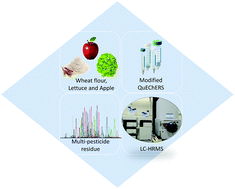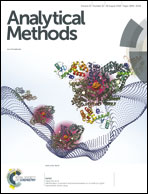Multi-pesticide residue analysis by high resolution mass spectrometry in complementary matrices: wheat flour, lettuce and apple samples†
Abstract
Nowadays, food contamination with pesticide residues is prevalent, which can cause problems to human health. For the analysis of these compounds in foods, multi-residue methods for specific matrices, which are not flexible, are normally developed. In this line, this study aimed to develop an analytical method using separation for ultra-fast liquid chromatography (UFLC) and analysis by high resolution mass spectrometry with ionisation by electrospray (ESI) and separation by quadrupole-time-of flight (ESI-Q-TOF) for the screening and confirmation of 93 pesticides in different kinds of foods (apple, lettuce and wheat flour). The method was based on QuEChERS (Quick Easy Cheap Effective Rugged Safe) with a subsequent dilution. This was validated in terms of linearity, precision and trueness, and limits of detection and quantification ranged from 1 to 10 μg kg−1 and 5 to 20 μg kg−1, respectively, with recoveries between 70 and 120% and a relative standard deviation (RSD) <20%. The compound confirmation was based on the exact mass as well as the isotope ratio. From sixteen real samples, three pesticide residues were detected in wheat flour samples, three in lettuce samples and four in apple samples. However, the concentrations detected (ranging from 2.7 to 408.0 μg kg−1) did not exceed the maximum residue limit (MRL) set by the European Union and Brazilian Health Surveillance Agency (ANVISA) through the Program for Analysis of Pesticide Residues (PARA). This practical method developed here was applied with success to different matrices for the analysis of pesticide residues in food with accuracy and sensitivity. Thus, a single method (which did not require complementary analysis) and an extraction procedure are useful for reducing pesticide identification errors in different food matrices.



 Please wait while we load your content...
Please wait while we load your content...